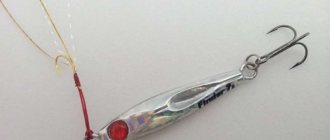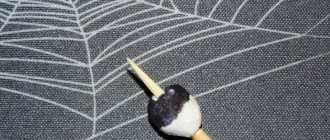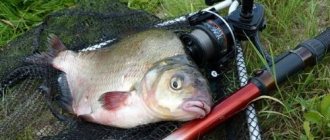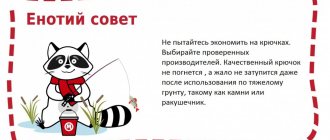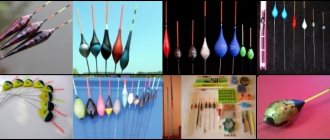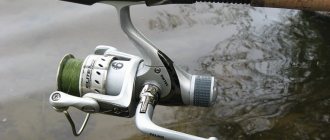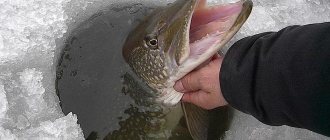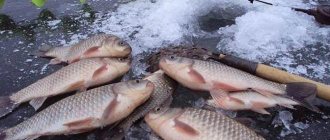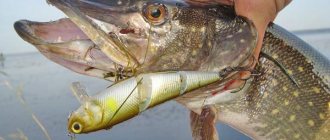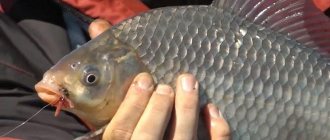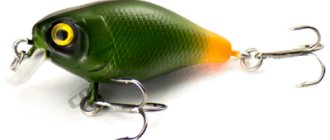Recently, baits with a minnow body shape have become the most popular among spinning anglers - although they are largely dependent on the skill of the fisherman, they are capable of producing stable results and leave room for experimentation when retrieving. However, multi-component wobblers, which have been undeservedly forgotten by many due to their design features, have a number of features that are absent in lures with a simpler body design. The body, consisting of several movably connected segments, when moving, makes movements very similar to those made by a living fish. The wide variety of models allows you to choose the bait that is most suitable for fishing conditions in a particular body of water.
Design features
Compound wobblers often have the same body shape as single-piece models of this type of spinning lure. However, the body is not a continuous sealed structure, but is divided into several (usually 2 or 3) sections, which are movably connected.
At the same time, the movement of the wobbler parts in the vertical plane is minimal, but in the horizontal plane it varies significantly depending on the model and manufacturer - some have a greater amplitude of movement, others have less. This has a direct impact on the aggressiveness of the bait when retrieved. The additional mobility of the bait's body enlivens its game, making it as similar as possible to the movements of a live fish.
Varieties of composite baits
Like single-part wobblers, joints can be classified according to the main characteristics:
- With or without spatula.
Photo 1. Wobbler without a blade.
- Sinking, floating and suspenders (sometimes they also distinguish between slow and fast sinking or floating).
- Noisy or without noise capsule.
- The baits also differ in shape. You can find models more similar to minnows, and a little less often - shad and fat.
Depending on these parameters, the use of different wobblers will be most effective in certain conditions. So, for fishing at great depths, a sinking option with a blade is most suitable. The presence of a blade will allow such a bait to sink to the working depth as quickly as possible, and negative buoyancy will allow the bait to sink to the bottom of the deepest holes.
Photo 2. Joint with a spatula.
The opposite of such a wobbler - a joint without a blade (or with a small short blade) and with positive buoyancy is best suited for shallow waters. The pop-up bait can be easily carried both through a shallow bay and over tall thickets of aquatic vegetation.
In the case of additional acoustic effects, there is no consensus among spinners.
It is generally accepted that in muddy water it is better to use options with a noise capsule, and in clear water - silent models. However, some fishermen remove them themselves, or add a noise effect for their wobblers. Important! To work normally with most composite lures, especially if twitching is primarily intended, you need a fairly strong, fast-action spinning rod.
What to look for when buying a wobbler
For successful fishing you need a catchy wobbler. To choose the right bait, you should pay attention to the following characteristics:
- on its buoyancy;
- coloring book;
- dimensions;
- immersion depth;
- wobbler game.
Buoyancy
As mentioned above, wobblers are characterized by buoyancy, which can be: positive, neutral and negative. Wobblers with positive buoyancy. Such baits remain on the surface of the water after casting. Once wiring begins, they are buried to a certain depth.
After reeling in the fishing line, they float to the surface of the water again. They are good for use in shallow waters or for fishing in shallows.
In summer, pike stays closer to the upper layers of water, so floating wobblers are the most catchy during this period. Wobblers with negative buoyancy. Such baits are more suitable for fishing in spring and autumn, when pike begin to move to depth.
At the same time, it should be borne in mind that larger individuals prefer depth. Therefore, mostly large specimens are caught using sinking wobblers. Wobblers with neutral buoyancy. Such baits are best used for fishing in the middle layers of water, as they do not sink or float. Somewhere at the beginning of summer or at its end, such baits will be just right for catching a toothy predator.
Immersion depth
Depending on the design and purpose, wobblers have different immersion depths. Each model must indicate the depth to which the wobbler can dive. The depth of penetration depends on the design of the blade, as well as on its angle of inclination.
The larger this angle, the deeper the bait can dive.
In addition, the depth of its work will depend on factors such as wiring speed. The faster the fishing line is reeled in, the deeper the wobbler will go under the water. Some models are capable of diving to depths of up to 10 meters.
Lure color
Coloring, although not always, has a serious impact on fishing performance. This is especially true when the pike begins to pick at baits very much. But she doesn’t go through them too much before spawning, when she has a glutton and is ready to swallow any bait that is suitable for her size.
The rest of the time, in order to catch a pike, you need to interest it. In this case, there is nothing to interest her other than the color of the bait.
When choosing a color, you need to adhere to some rules:
- When “hunting” for pike on a clear sunny day, when it needs to be provoked to attack, it is better to give preference to bright blue or light blue lures. When fishing in shallow water, wobblers of a silver or bronze hue may appear in the same conditions.
- On cloudy days and in dark water, gold-colored baits are out of competition. Turbid water requires the use of bright baits that are visible at optimal distances. The most suitable baits are those painted in bright red, yellow or acidic shades. The best option is to use wobblers coated with fluorescent paint. The deeper, the more preferable lures with gold or yellow colors may be.
Types of bait
Today's fishing industry is developing very quickly. Many of the newest gear models are hard to keep up with. It is even more difficult for beginners to understand every little detail. For this reason, at the very beginning we will try to give an idea of which wobbler to choose for pike, and what types of wobblers they generally have.
Specialized stores are filled with a variety of spinning rods, but not all of them are good.
Depending on the layer of water in which a particular wobbler is used, they are divided into 3 categories of depth:
- Deep sea models. When guiding, they descend to great depths.
- Subsurface wobblers. They work in different styles: they can “walk” along the surface of a reservoir, but they can also dive to a meter depth.
- Surface models. When inserted, such wobblers do not go deeper than 10 cm.
Depth directly depends on the buoyancy of the wobbler. It also comes in three types:
- Sinking wobblers. After casting, they sink to the bottom of the reservoir. As soon as wiring begins, they either begin to go deeper or float to the surface. It depends on the design of the wobbler.
- Floating wobblers for pike. They lie on the water surface. They can go deeper due to the blade when wiring, which is moved forward.
- Suspenders (neutral). They remain at the depth where the wiring stopped.
Such baits are also classified according to their shape. They are bladeless and bladed.
Bladed wobblers:
- Shad is a flat bait similar to saberfish or bleak.
- Fat is a short, tall model.
- Wobbler for pike Crank is something between Fat and Shad.
- Minnow is a long wobbler similar to a minnow. It is in great demand and can be called the most popular of all blade baits.
Bladeless options:
- Crawler is a wobbler with a wide blade in the form of wings.
- Popper is the most popular surface model. The main difference from other wobblers is the presence of a recess in the spout area. It gurgles when wired.
- Rattlin is a diamond-shaped wobbler. Attaches to the ring on the back.
- Jerk bait is a big rattlin that needs jerking retrieves. Attaches to the nose ring.
- Darter is a long-bodied, narrow Rattlin. They call him stupid.
- Stickbait is a thin-bodied, long wobbler. Similar to the Minnow, but without the blade.
The main advantages of wobblers for pike over silicone and other lures:
- pike can be caught with a stationary bait;
- similarity to the fish that pike eat in natural conditions;
- wobblers can be launched with high accuracy over long distances downstream;
- the bait imitates the movement of fish;
- various colors;
- the wobbler immediately “starts working” at the first touch of the water surface; the longer it is in the water, the greater the likelihood of a bite;
- the bait is equipped with a rattle that creates a noise effect that attracts the predator;
- increased fishing efficiency; the fish practically does not leave the bait;
- the fisherman has complete control over the behavior of the wobbler;
- wear-resistant and serve for a long time.
You need to pay attention to the size of the wobbler, shape and color. The bait can be “natural”, that is, it has a normal color with clearly drawn details: fins, eyes, scales. There are also so-called “acid” baits.
They combine bright, unnatural colors. It is curious, but it has been noticed that pike often prefer them more than “natural” ones.
Perhaps because “acid” ones are more visible under water. The size of a wobbler can range from 3 to 30 cm. The most convenient baits have a size of 5-10 centimeters. Wobblers come in elongated shapes that imitate perch or roach, narrow ones that look like fry, and three-dimensional ones that resemble larger fish. It is pike that prefers voluminous species.
Minnow class models (Jackall Squad Minnow 80 SP) and Cranky class (Megabass Griffon SR-X) are excellent for shallow water. Deep-sea pike fishing involves the use of baits that dive 5 m or more. Suitable options: Rapala Down Deep, Stretch 1-Minus.
In rivers without current or if it is minimal, you can use any type of wobbler. But in bodies of water with a current, it is wiser to use sinking baits and suspenders. Cranks and Shads are recommended, such as Ever Green Tiny Predator, Lucky Craft Bevy Shad.
There are several options for wobblers for catching pike on the surface. The main wiring will be various twitching options, so a short rod (up to 2.4 m) with a fast action is required.
The most famous surface baits are poppers. When guiding, they make splashes on the surface of the water, attracting a predator. Walkers are distinguished by their prowling game, which is similar to a dog walking on a leash. With a uniform retrieve, the wolf does not play, so fishing success will largely depend on the skills of the spinner.
Jerkbaits attract pike with their large size, noise and impressive waves when retrieved. Lures with propellers are called propbaits. You can fish with them either by twitching or by uniform reeling. They operate stably in large waves and strong winds.
Crawlers are great for night fishing in shallow water. These wobblers have a wide blade that produces a characteristic sound and creates a large wave. Gliders are capable of passing through the most overgrown areas of the reservoir.
They glide along the surface of the water and do not cling to the grass thanks to a hidden or vertically raised hook.
To catch pike in deep places on the current, it is effective to use sinking wobblers. This bait sinks to the bottom without additional weights, playing as it falls. It is this quality that becomes attractive to pike. Very often the fish grabs the bait immediately after casting.
It is important at this moment not to lose contact with the bait; for this, the fishing line must be in a taut state. The wiring can be slow and fast, uniform and stepped.
The shape of sinking wobblers varies:
- Shads;
- Cranky;
- Fats;
- Rattlin minnows.
They have different immersion depths and differ in how they play when retrieved. It is best to use sinking wobblers to fish for pike sites such as dumps and holes, and hills at the bottom.
Benefits of use
A large assortment of wobblers, on the one hand, is an undeniable advantage, and on the other hand, it significantly complicates their choice. In this article we will describe in detail the advantages of wobblers when fishing for pike, name the ten best wobblers for pike, tell you how to choose a wobbler depending on the season and intended fishing location, and also give many useful tips.
Let's consider the advantages of wobblers over silicone baits, as well as other types of spinners:
- Amazing resemblance to the natural coloring of the fish that the predator feeds on.
- The ability to exactly follow the natural movement of a fish.
- The wobbler “starts working” as soon as it touches the water and the longer it stays in it, the higher the likelihood of a bite.
- Possibility of catching pike with a stationary wobbler.
- The use of floating wobblers allows you to lower them downstream over long distances with high accuracy.
- Variety of color palette.
- An additional noise effect arising from the rattle built into the body of the wobbler.
- The use of wobblers allows the spinner to completely control the movements of the bait, which has a positive effect on fishing performance.
- Minimum number of fish hatches.
- High-quality wobblers are wear-resistant, do not lose their performance over time and will last a long time.
You don’t always need to chase expensive well-known wobblers. Many budget models catch pike just as well as branded lures. An example of inexpensive wobblers for pike are Kosadaka lures.
For fishing at a depth of up to 1 m, Kosadaka Mascot and Ultima wobblers are suitable.
The Kosadaka Goru model works perfectly at a depth of 0.5 m, and the Kosadaka Intra is a favorite in shallow water, going down to 0.3 m. Among the catchy budget wobblers, the following models should be noted:
- Euro Minnow from Strike Pro.
- Duel by Yo-Zuri.
- Ecogear MW 72F.
- Baby Minnow.
- Hum Bug.
- Gripp by River2Sea.
Wobblers are considered the best bait for catching pike. You just need to find a model that will pass in the same horizon where the fish is standing.
Then the bite from the toothy predator will not take long to arrive. In overgrown grass or when fishing at night, you need a wobbler of a certain model. Budget models can also bring good results; it is only important to be able to handle them correctly. Source: “rybkolov.ru; fishingday.org; prostokaras.com; ranoutrom.com"
Color, length and weight
Fishing with composite wobblers also involves selecting the most suitable length, color and weight of the bait for specific conditions.
With length and weight, everything is more or less clear - the larger the size of the expected catch, the larger the bait should be. But when choosing, you should not forget about the characteristics of your fishing rod.
Important! Jerking movements of long-length wobblers may not be successful on a number of spinning rods even without exceeding the test form for the bait.
Coloring also matters. It is generally accepted to use bright, provocative wobblers in muddy water and poor lighting, and more natural colors in clear waters on a sunny day. However, it should be taken into account that this pattern is not always observed, and if the bite is bad, you need to actively experiment with both wiring and different models of bait.
Photo 3. A small compound painted to look like a perch.
Advantages and disadvantages of compounds
Composite wobblers have both certain advantages compared to lures of a simpler design, as well as disadvantages. Among the advantages it is worth highlighting:
- Versatility. Among the components you can find models suitable for catching any predator and in almost any fishing conditions.
- Game features. The body of solid wobblers does not have such mobility; the composite version is much more like a fish, and is attractive to a predator even with a simple uniform retrieve.
- The flexible body of the bait provides greater freedom to the hooks, which significantly reduces the risk of fish escape.
- Composite wobblers are one of the means by which spinners try to “stir up” inactive fish.
- Another important factor is that composite baits are suitable for almost any type of retrieve, from simple even fishing to aggressive twitching, which allows you to choose the most suitable animation method as you go fishing.
There are also disadvantages:
- According to many spinning anglers, the main drawback is the disgusting flight qualities. The casting range of composites is significantly less than that of solid models.
- Increased likelihood of hooking, even compared to a conventional bait of similar sizes and equipped with the same number of hooks.
- Possibility of breakage of the moving joint. Also, many models of joints have thin fins made of soft plastic, which quickly become unusable when fishing for pike.
Wiring
One of the most important factors for effective pike fishing with wobblers is various wiring. If a short crank with a steep blade is not very demanding on wiring, then many of the most branded and expensive wobblers refuse to catch with a uniform retrieve and show their signature best qualities only when using jerk wiring, twitching, and “stop&go” . At the same time, copies of the same branded models can catch pike well on a uniform retrieve, like some other models of wobblers. Here you will have to take an individual approach to choosing each wobbler for specific fishing conditions.
